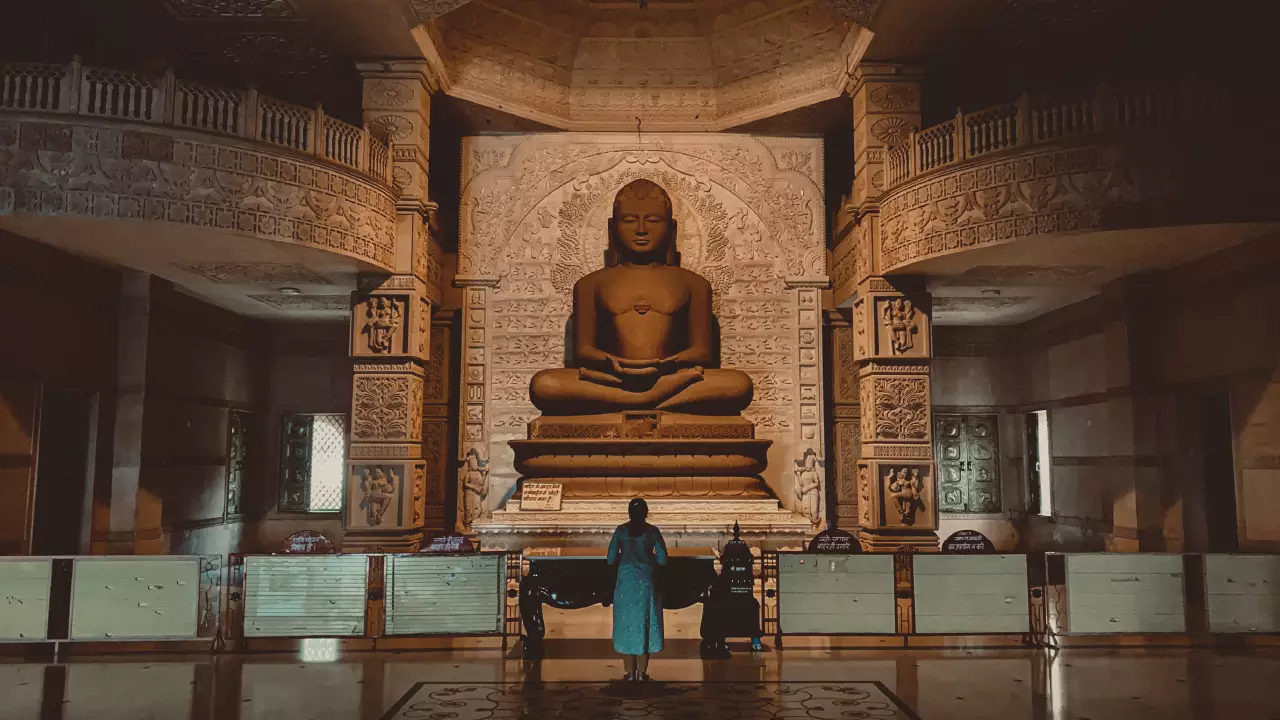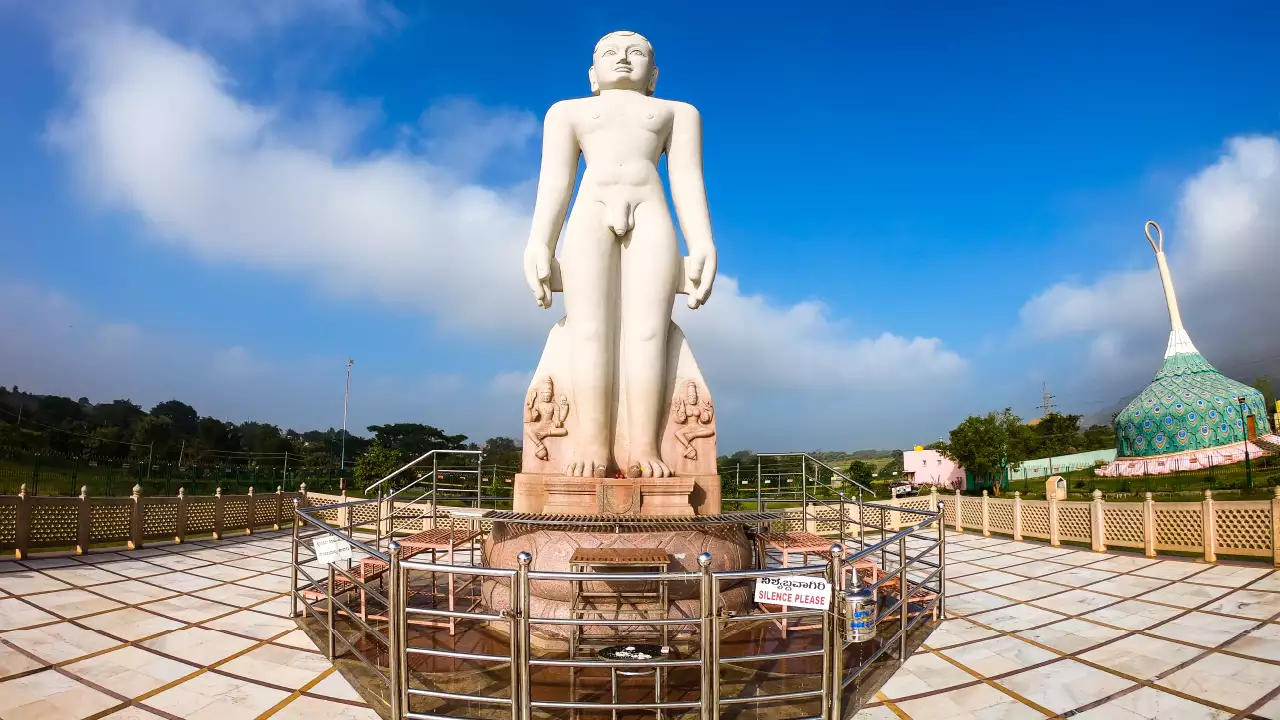Rituals and Practices: Paryushana and Meditation
Jainism, while deeply philosophical, is also rich in rituals and practices that allow its followers to embody its core principles in their daily lives. These rituals, steeped in ancient traditions, bridge the material and spiritual realms, guiding Jains on their path to self-realization.
Paryushana:
Significance: Often referred to as the most sacred festival for Jains, Paryushana is a time for introspection, penance, and purification. Spanning eight days for the Shwetambara sect and ten days for the Digambara sect, it’s a period of deep spiritual renewal.

Practices: During Paryushana, Jains undertake various religious activities, including fasting, reading scriptures, and attending discourses. The festival culminates in the celebration of Samvatsari or Kshamavani, a day dedicated to seeking and granting forgiveness. On this day, Jains greet each other with the phrase “Micchami Dukkadam,” expressing a desire for mutual forgiveness.
Meditation (Samayika):
Significance: Meditation, known as Samayika in Jainism, is a cornerstone of Jain spiritual practice. It’s a tool for self-discipline, introspection, and attaining inner peace. By practising Samayika, Jains aim to transcend worldly attachments and realize their true nature.
Practices: Typically lasting for 48 minutes, a Samayika session involves reciting mantras, reflecting on one’s actions, and meditating on universal truths. It’s a time to detach from the external world and delve deep into one’s inner self. Through regular practice, Jains cultivate mindfulness, compassion, and a heightened sense of purpose.
Beyond Paryushana and Samayika, Jainism encompasses a plethora of rituals and ceremonies, from birth to death. Each ritual, whether it’s the initiation of a monk or the consecration of a temple, is imbued with profound symbolism, reflecting Jainism’s deep reverence for all forms of life and its commitment to spiritual growth.

Jain Architecture: Temples and Monuments
Jainism, with its rich history and spiritual depth, has left an indelible mark on India’s architectural landscape. Jain temples, known for their intricate carvings, grandeur, and spiritual ambience, are not just places of worship but also masterpieces of art and architecture that reflect the religion’s reverence for life and the universe.
Distinctive Features:
Intricate Carvings: Jain temples are renowned for their detailed carvings, depicting tales from Jain scriptures, images of Tirthankaras, and various symbols representing Jain cosmology and philosophy.
Temple Complexes: Many Jain temples are part of larger complexes, often located on hilltops or amidst serene landscapes, further enhancing their spiritual ambience. These complexes often include multiple shrines, assembly halls, and sometimes libraries.
Notable Temples:
Dilwara Temples, Rajasthan: Located near Mount Abu, these temples are epitomes of marble craftsmanship. The intricate carvings, especially in the central domes, are a testament to the artisans’ unparalleled skill.

Ranakpur Jain Temple, Rajasthan: Dedicated to Tirthankara Adinatha, this temple is known for its 1,444 uniquely carved pillars, no two of which are the same.
Palitana Temples, Gujarat: Situated atop the Shatrunjaya hills, this complex comprises over 800 temples, making it one of the most significant pilgrimage sites for Jains.
Monuments and Structures:
Gomateshwara Statue, Karnataka: Located in Shravanabelagola, this colossal monolithic statue of Bahubali is one of the most significant Jain monuments. Every 12 years, it becomes the site of the Mahamastakabhisheka festival, where the statue is anointed with various substances in a grand ceremony.
Ellora Caves, Maharashtra: Among the 34 caves at Ellora, 12 are dedicated to Jainism. These caves, carved between the 5th and 10th centuries, showcase the evolution of Jain art and architecture over the centuries.
Symbolism in Architecture: Jain temples often incorporate symbols like the lotus, representing purity, and the swastika, symbolizing the cycle of birth and death. The positioning of idols, the design of the sanctum, and even the temple’s layout are deeply symbolic, reflecting Jain’s cosmology and beliefs.
In essence, Jain architecture is a harmonious blend of spirituality, art, and devotion. Each structure, with its intricate designs and profound symbolism, serves as a testament to Jainism’s rich heritage and its timeless principles of reverence for all forms of life.
Jainism Today: A Legacy of Peace
In today’s fast-paced and often tumultuous world, the timeless principles of Jainism offer a beacon of hope and tranquillity. Despite being one of the older religions, its teachings resonate profoundly in contemporary society, emphasizing peace, compassion, and coexistence.
Global Presence:

Diaspora Communities: Jain communities have flourished not just in India but around the globe. From North America to Europe and Africa, Jain temples and cultural centres have become hubs for spiritual activities, community gatherings, and preserving traditions.
Interfaith Dialogues: Jains actively participate in interfaith dialogues, promoting mutual respect, understanding, and shared values among diverse religious groups.
Modern Adaptations:
Digital Platforms: The teachings of Jainism have found a new home on digital platforms. Online discourses, virtual temple tours, and apps focused on Jain meditation and scriptures cater to the younger generation and those unable to visit temples regularly.
Eco-friendly Initiatives: Embodying the principle of Ahimsa, many Jain communities champion eco-friendly practices. From tree-planting drives to campaigns against animal cruelty, Jains are at the forefront of environmental and ethical initiatives.
Educational Institutions:
Jain Universities and Schools: Institutions like Jain University in Bangalore focus not only on academic excellence but also on inculcating values of non-violence, ethics, and community service.

Research and Publications: Numerous research centres and publications delve into Jain philosophy, history, and art, ensuring that the rich legacy of Jainism is preserved and disseminated to future generations.
Social Contributions:
Charity and Philanthropy: Guided by the principle of Aparigraha, many Jains engage in charitable activities, establishing hospitals, educational institutions, and community centres.
Vegetarianism and Veganism: Jainism’s emphasis on non-violence has made many Jain pioneers in promoting vegetarianism and, more recently, veganism, highlighting the ethical and environmental implications of food choices.
In conclusion, Jainism today is not just a religion confined to rituals and scriptures; it’s a living philosophy that continues to inspire millions. Its legacy of peace, forged over millennia, serves as a testament to the enduring power of non-violence, compassion, and harmony in an ever-evolving world.




























